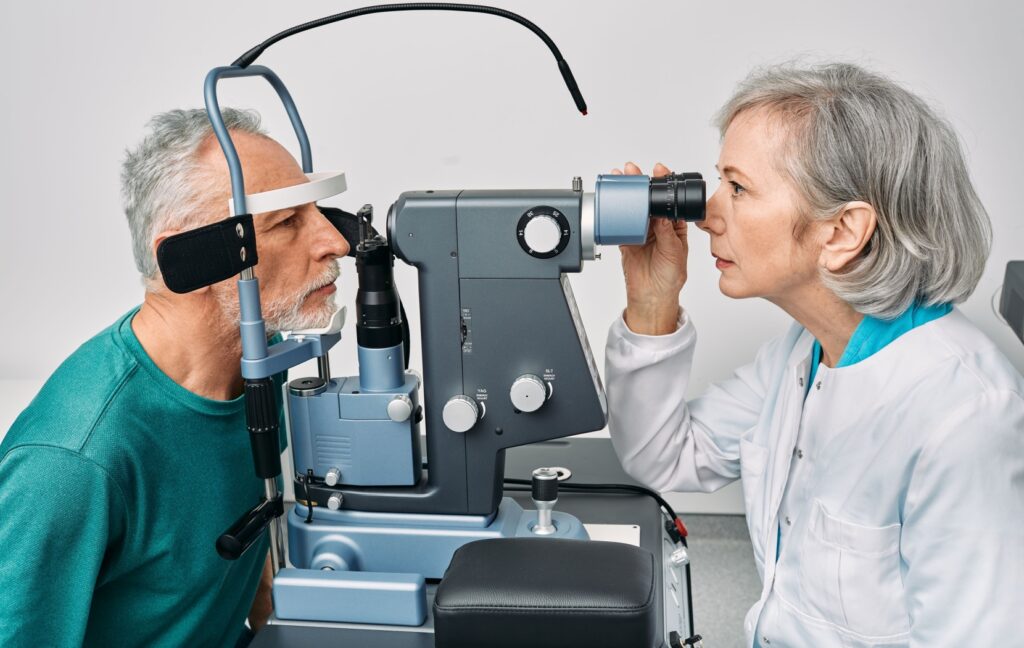Most people book an eye exam when they notice changes in their vision or need a new prescription. But comprehensive eye exams reveal much more than whether you need glasses or contact lenses; they can detect early signs of diabetes before you experience any symptoms.
Your eye doctor can spot changes in the blood vessels of your retina that often signal diabetes-related complications. These changes frequently appear before you notice any symptoms elsewhere in your body, making regular eye exams a powerful tool for early detection and prevention.
The Connection Between Your Eyes & Overall Health
Your eyes offer a unique window into your overall health. The tiny blood vessels in your retina are highly sensitive to changes in blood sugar levels, making them excellent early indicators of conditions such as diabetes.
Many systemic diseases, including diabetes, can first manifest in the eyes before affecting other parts of the body. This is why routine eye exams serve as crucial health check-ups, not just vision screenings.
How Diabetes Impacts Your Eyes
Diabetes is a chronic condition where your body struggles to regulate blood sugar levels. When your body doesn’t produce enough insulin or can’t use insulin effectively, blood sugar levels rise throughout your body, including in the delicate blood vessels of your eyes.
High blood sugar levels can damage the small blood vessels in your retina, leading to several serious eye conditions, including:
- Diabetic retinopathy occurs when elevated blood sugar damages retinal blood vessels, potentially causing leakage, swelling, or abnormal blood vessel growth that can lead to vision loss.
- Macular edema develops when fluid accumulates in the macula (the part of your retina responsible for sharp central vision), resulting in blurry or distorted sight.
- Glaucoma can develop when diabetes-related complications increase pressure inside your eye, damaging the optic nerve and potentially causing peripheral vision loss or blindness.
- Cataracts involve clouding of your eye’s natural lens, causing blurry vision and increased sensitivity to light.
Warning Signs of Diabetes in the Eyes

Diabetic eye disease often develops silently, without early warning signs. This makes routine eye exams essential for detecting changes in your eye health. However, as the condition progresses, you might experience:
- Blurry or fluctuating vision
- Sudden vision loss
- Frequent prescription changes
- Dark spots or floaters
- Increased light sensitivity
Recognizing these symptoms early allows for timely intervention that can help prevent permanent vision loss.
How Regular Eye Exams Can Detect Diabetes
During a comprehensive eye exam, your optometrist can identify early signs of diabetes by carefully examining your retina and blood vessels. These exams help detect tiny hemorrhages, fluid leakage, or structural changes in blood vessels—all potential indicators of diabetic complications.
Your eye doctor might notice:
- Retinal bleeding or swelling suggesting early diabetic changes
- Narrowed or damaged blood vessels indicating poor circulation from high blood sugar
- Unusual deposits in the retina signalling potential diabetes-related eye health issues
If your optometrist suspects diabetes based on these findings, they’ll refer you to a primary care physician for further testing and diagnosis.
What Happens During a Diabetic Eye Exam
For those with diabetes or those at high risk, annual diabetic eye exams are recommended to monitor for signs of diabetic eye disease. These specialized exams include specific tests beyond standard vision checks to detect and monitor early complications.
Key Tests in a Diabetic Eye Exam
Your eye doctor will perform various evaluations, including:
- Retinal imaging captures detailed photographs of your retina to support early detection of diabetic retinopathy and track changes over time.
- Optical coherence tomography (OCT) provides cross-sectional images of your retina through a non-invasive scan, helping detect swelling or fluid buildup in the macula.
Even without noticeable symptoms, a diabetic eye exam can detect early changes, allowing for prompt treatment.
Preventing Diabetic Eye Complications
Whether you have diabetes or not, taking proactive steps can help protect your vision and overall health. Here are several ways to reduce your risk of developing diabetic eye disease:
Schedule Regular Eye Exams
Annual comprehensive eye exams help detect changes before they impact your vision, allowing for early intervention.
Manage Blood Sugar Levels
Keeping blood sugar within a healthy range helps protect the blood vessels in your retina from damage.
Maintain a Healthy Lifestyle
Regular exercise, a balanced diet, and weight management can help prevent or control diabetes and its complications.
Quit Smoking
Smoking increases your risk of diabetic retinopathy and other vision problems, so quitting provides significant benefits.
Monitor Your Eye Health
If you notice sudden changes in your vision, seek medical attention promptly rather than waiting for your next scheduled appointment.
Consistently following these preventive measures can significantly reduce your risk of diabetic complications and support long-term eye health.
Protect Your Vision with Northern Lights Eyecare
Routine eye exams do much more than check for vision problems—they can detect serious health conditions like diabetes before symptoms appear. If you’re at risk for or have been diagnosed with diabetes, regular eye exams are essential for monitoring changes and preventing vision loss.
At Northern Lights Eyecare, we offer comprehensive diabetic eye exams specifically designed to detect early signs of eye disease and safeguard your long-term vision. Schedule an appointment today to take proactive steps toward maintaining clear, healthy vision for years to come.


